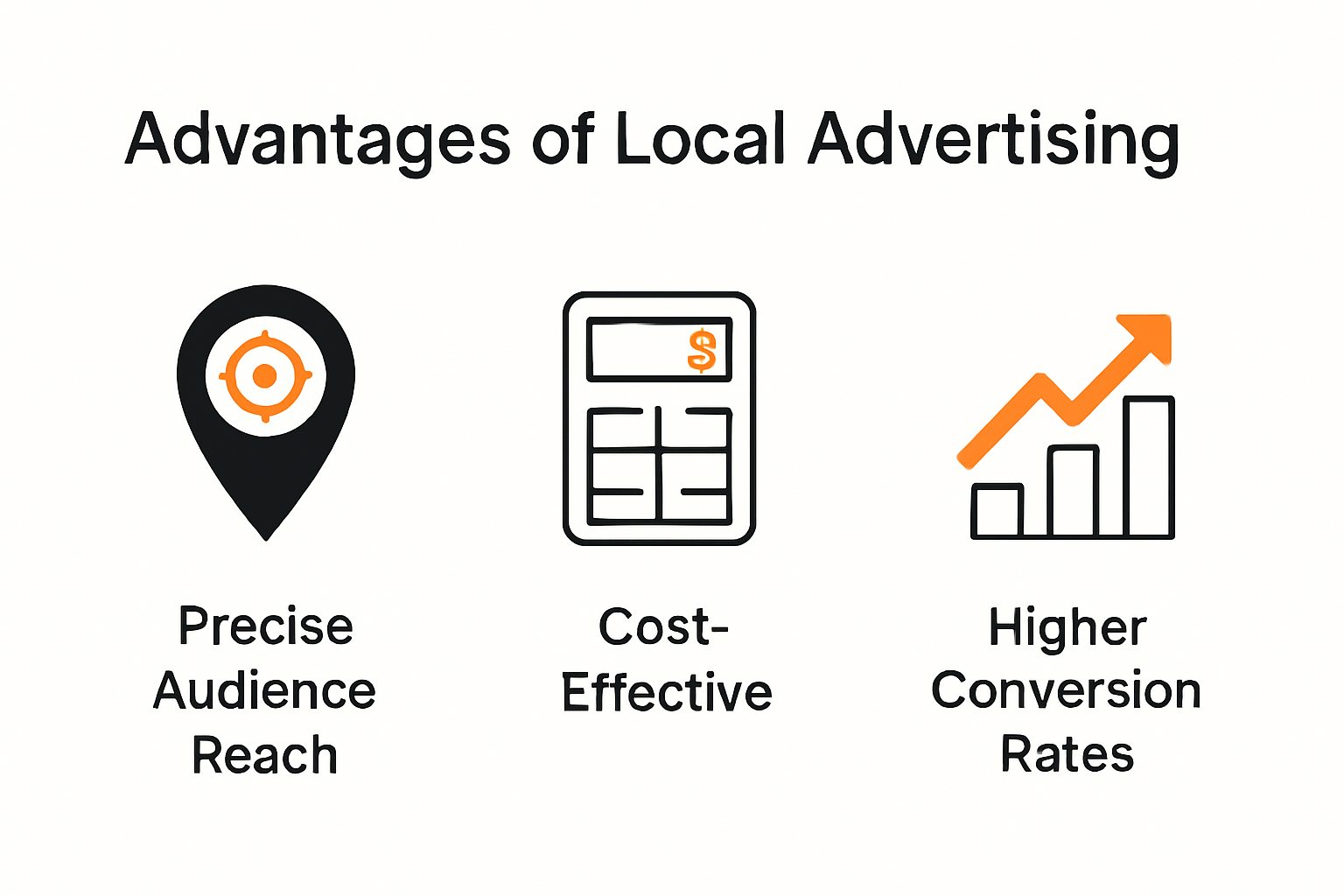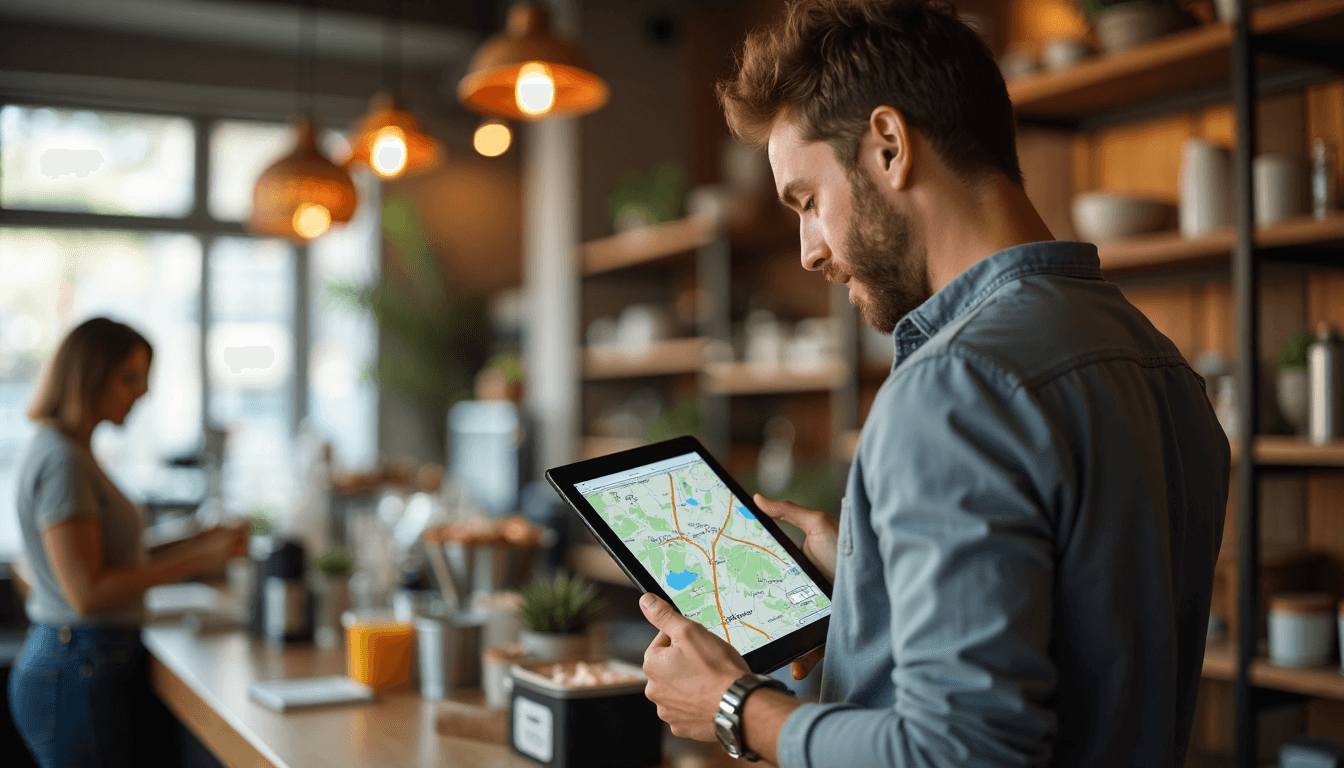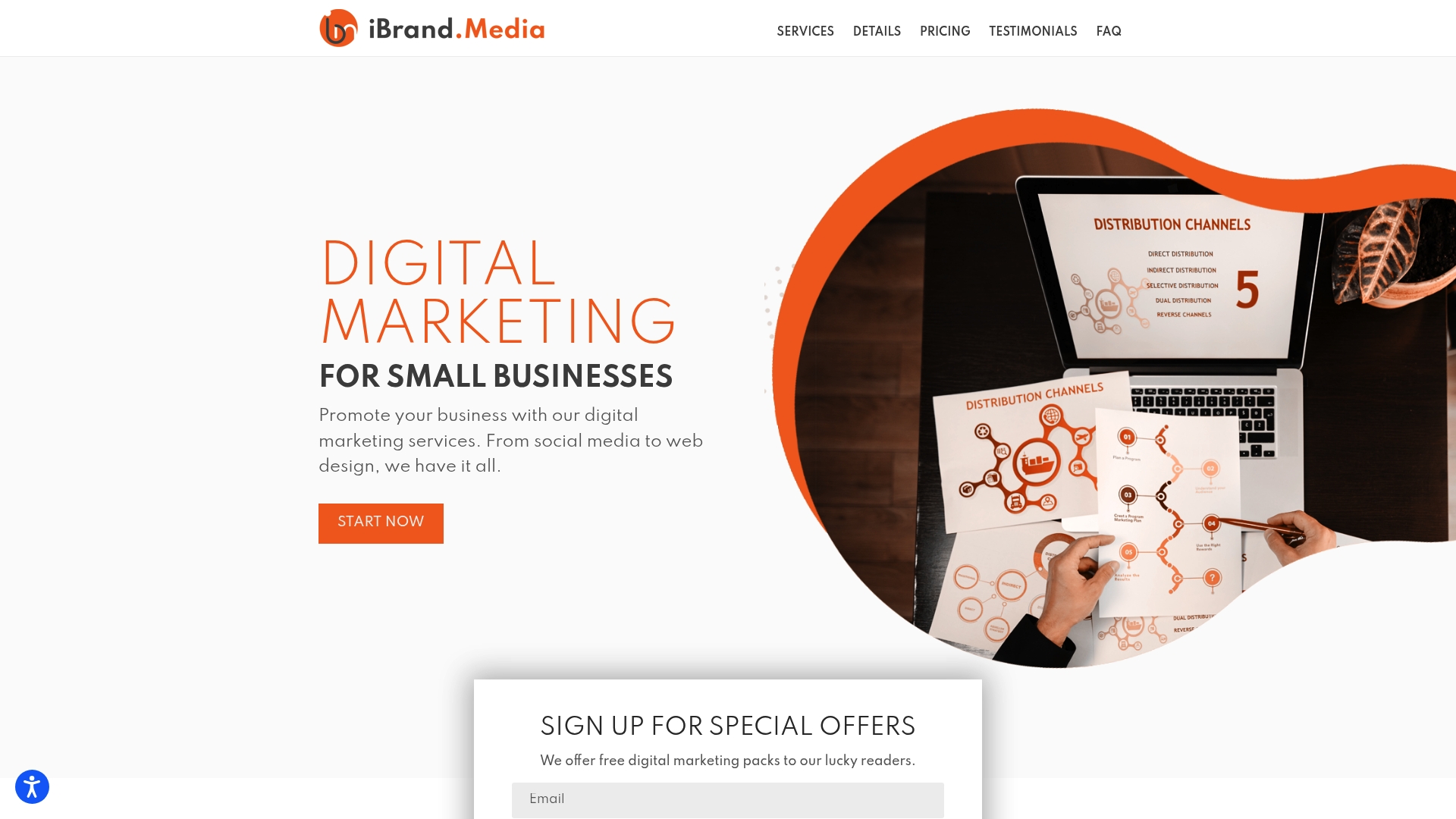
Local ads are changing the way businesses connect with their communities. Here is the shocker. Brands using local ads see conversion rates jump by up to 50 percent compared to broad campaigns. It sounds simple, but the real secret is not just about reaching people nearby. It is about winning trust and becoming the go-to choice in your neighborhood before competitors even show up.
Table of Contents
- Understanding Local Ads And Their Benefits
- Choosing The Right Platforms For Local Ads
- Step-By-Step Setup Of Your First Local Ad
- Tips To Maximize Local Ad ROI In 2025
Quick Summary
| Takeaway | Explanation |
|---|---|
| Precise Audience Reach | Local ads allow businesses to target consumers within a specific radius, optimizing marketing spend and improving conversion rates by connecting with nearby customers. |
| Building Community Trust | Engaging in local advertising helps businesses establish credibility and build trust within their community by addressing local issues and participating in regional contexts. |
| Platform Selection Matters | Choosing the right advertising platform is crucial; match platform demographics with target audiences for effective outreach and consider unique strengths of each platform for optimal results. |
| Data-Driven Advertising | Utilize robust analytics from local advertising platforms to continuously measure performance and refine strategies, ensuring ongoing optimization and effective targeting. |
| Integrated Marketing Approach | Maximize ROI through a multi-channel strategy that combines various marketing efforts, ensuring a consistent customer experience and stronger engagement across all touchpoints. |
Understanding Local Ads and Their Benefits
Local advertising represents a strategic approach for businesses to connect directly with potential customers in specific geographic areas. By focusing marketing efforts on a targeted local audience, businesses can maximize their advertising impact and efficiency.
The Power of Geographical Targeting
Local ads enable businesses to reach consumers within a precise radius, making every marketing dollar count. Discover more about local marketing strategies that can transform your business approach. According to research from business.qld.gov.au, location-based marketing strategies allow businesses to allocate resources more efficiently by concentrating on specific regions.
The key advantages of local advertising include:
- Precise Audience Reach: Target consumers most likely to engage with your business
- Cost Effectiveness: Reduce wasted ad spend by focusing on relevant geographic areas
- Higher Conversion Rates: Connect with customers who are physically close and more likely to take immediate action


Building Community Trust and Credibility
Local advertising goes beyond simple promotion. As the U.S. Chamber of Commerce highlights, these marketing efforts help businesses build trust and credibility within their community. By addressing local issues and showcasing expertise, businesses position themselves as trusted local authorities.
This approach creates a deeper connection with potential customers. When consumers see a business actively participating in and understanding local contexts, they are more likely to choose that business over competitors. Local ads can include community-specific messaging, local event sponsorships, or targeted content that resonates with regional interests and needs.
Measuring Local Ad Performance
Modern local advertising platforms provide robust analytics that allow businesses to track their performance with unprecedented precision. Businesses can now measure metrics such as:
- Geographic engagement rates
- Conversion rates from specific neighborhoods
- Cost per local customer acquisition
- Real-time response and interaction data
These insights enable continuous optimization of marketing strategies, ensuring that businesses can adapt their approach based on actual performance data. By understanding which local areas respond best to specific messaging, businesses can refine their targeting and improve overall marketing efficiency.
Local ads represent more than just a marketing tactic. They are a sophisticated approach to connecting with potential customers, building community relationships, and driving business growth through targeted, intelligent marketing strategies.
Choosing the Right Platforms for Local Ads
Selecting the appropriate advertising platforms is critical for local businesses seeking to maximize their marketing efforts and reach potential customers effectively. The digital advertising landscape offers numerous options, each with unique strengths and targeting capabilities.
Understanding Platform Demographics and Reach
Successful local advertising requires a strategic approach to platform selection. Learn more about optimizing online advertising channels to enhance your marketing strategy. According to Forbes research, aligning platform demographics with your target market is crucial for advertising success.
Key considerations when choosing local ad platforms include:
- Audience Match: Ensure the platform’s user base aligns with your target customer profile
- Content Compatibility: Select platforms that support your preferred content format
- Budget Constraints: Evaluate cost-effectiveness and potential return on investment
Below is a comparison table summarizing the unique strengths and best uses of popular local advertising platforms discussed in this section.
| Platform | Unique Strength | Best For |
|---|---|---|
| Google Ads | Precise geographic targeting | Local search results, immediate intent |
| Detailed demographic/interest targeting | Community building, local social outreach | |
| Visual storytelling | Visually-driven businesses (retail, food) | |
| Professional audience targeting | B2B local service providers | |
| YouTube | Video content marketing | Local brand awareness via video ads |
Platform-Specific Advertising Strategies
Different platforms offer unique advantages for local businesses. Insights from the Institute of Local Marketing highlight the importance of matching content format to platform strengths. For instance:
- Google Ads provides precise geographic targeting for local search results
- Facebook allows detailed demographic and interest-based targeting
- Instagram works best for visually-driven businesses like restaurants and retail stores
- LinkedIn remains ideal for B2B local service providers
- YouTube enables video content marketing for local businesses
As TV Scientific reports, many platforms offer cost-effective options with interactive features like click-to-call buttons and customer review integrations, which can significantly boost local engagement.
Measuring Platform Performance
Effective local advertising requires ongoing performance tracking and optimization. Modern advertising platforms provide sophisticated analytics that help businesses:
- Track geographic engagement rates
- Analyze conversion metrics
- Compare cost-per-acquisition across different channels
- Refine targeting strategies based on real-time data
Businesses should approach platform selection as a dynamic process, continuously testing and adjusting their strategies. What works for one local business might not work for another, making experimentation and data-driven decision-making essential.
Ultimately, the right platform depends on your specific business goals, target audience, budget, and content strategy. By carefully evaluating each platform’s strengths and aligning them with your marketing objectives, you can create a powerful local advertising approach that drives meaningful results.
Step-by-Step Setup of Your First Local Ad
Creating an effective local ad requires a strategic and methodical approach. Explore our comprehensive guide to local marketing to enhance your understanding of digital advertising strategies. By following a structured process, businesses can maximize their advertising impact and reach their target audience more effectively.
Defining Your Advertising Objectives
Before launching a local ad campaign, businesses must establish clear and measurable goals. According to research from current.marketing, defining your campaign’s objective is the critical first step. Your goals might include:
- Increasing Local Foot Traffic: Drive more customers to your physical location
- Generating Leads: Capture potential customer contact information
- Boosting Online Engagement: Increase website visits or social media interactions
- Promoting Specific Products or Services: Highlight new offerings or seasonal promotions
Each objective requires a tailored approach to ad creation and targeting. For instance, a lead generation campaign will differ significantly from an awareness-building campaign.
Keyword and Targeting Strategy
OneBase Media recommends conducting thorough keyword research to ensure your ad reaches the most relevant audience. This involves:
- Identifying high-intent local keywords
- Using geo-targeting tools to define your precise audience location
- Creating a geographic radius that matches your business service area
- Excluding regions that are outside your practical service range
Precise targeting helps optimize your advertising budget by focusing on the most promising potential customers. For local businesses, this means narrowing your audience to those most likely to engage with your specific offerings.
Technical Setup and Ad Creation
The final stage involves the technical implementation of your local ad campaign. Key steps include:
- Selecting the most appropriate advertising platform for your business
- Creating compelling ad copy that speaks directly to local customers
- Designing visually appealing graphics or videos
- Setting up tracking mechanisms to measure ad performance
- Establishing a reasonable budget allocation
- Configuring conversion tracking to monitor meaningful interactions
Businesses should approach their first local ad as a learning opportunity. Start with a modest budget, carefully monitor performance, and be prepared to make rapid adjustments based on initial results.
Successful local advertising is an iterative process. Each campaign provides valuable insights that can be applied to future marketing efforts. By maintaining a data-driven approach and remaining flexible, businesses can continuously improve their local advertising strategies and achieve more meaningful connections with their target audience.
Here is a step-by-step summary table outlining the key stages to set up your first local ad campaign, from defining objectives through technical execution.
| Step | Key Actions | Purpose |
|---|---|---|
| 1. Define Advertising Objective | Set clear, measurable campaign goals | Guide targeting and messaging |
| 2. Keyword & Geo Targeting | Research local keywords; set geographic radius | Reach relevant local audience |
| 3. Select Advertising Platform | Choose best-fit platform for business & goals | Maximize targeting effectiveness |
| 4. Ad Creation | Write ad copy; design visuals/videos | Engage local customers |
| 5. Setup Tracking & Budget | Configure analytics; allocate reasonable budget | Monitor and optimize performance |
| 6. Launch & Optimize | Run, monitor, and adjust based on data | Continuous campaign improvement |
Tips to Maximize Local Ad ROI in 2025
Maximizing return on investment (ROI) for local advertising requires a strategic and data-driven approach. Explore our comprehensive local online marketing strategies to stay ahead in the competitive digital landscape. Businesses must continuously refine their advertising techniques to ensure every marketing dollar delivers meaningful results.
Strategic Budget Allocation
According to Google Business insights, successful marketing requires a balanced approach to budget allocation. Businesses should consider:
- Brand-Building Activities: Allocate 50-60% of marketing budgets to long-term brand development
- Performance Tactics: Dedicate 40-50% to direct response and conversion-focused strategies
- Continuous Performance Monitoring: Regularly assess and reallocate resources based on campaign performance
This balanced approach ensures both immediate results and sustainable long-term growth, preventing over-investment in short-term tactics.
Advanced Targeting and Technology
Excellent Publicity research highlights the importance of leveraging cutting-edge technologies. Programmatic media buying emerges as a game-changing strategy for local advertisers. Key technological advantages include:
- AI-driven audience targeting
- Real-time ad space bidding
- Precision audience segmentation
- Dynamic pricing optimization
- Automated performance tracking
Businesses can use these technologies to minimize wasted ad spend and maximize engagement with the most relevant potential customers.
Multi-Channel Marketing Integration
Evokad’s digital marketing research emphasizes the power of integrated marketing approaches. Successful local advertising in 2025 requires a holistic strategy that combines:
- Email marketing campaigns
- Social media advertising
- Search engine optimization (SEO)
- Content marketing
- Offline marketing efforts
By creating a seamless customer experience across multiple channels, businesses can:
- Increase brand visibility
- Improve customer engagement
- Enhance conversion rates
- Build stronger customer relationships
The key to maximizing local ad ROI lies in continuous learning and adaptation. Businesses must remain agile, regularly analyzing performance metrics, testing new approaches, and quickly pivoting strategies that aren’t delivering expected results.
In the rapidly evolving digital marketing landscape, success comes to those who combine technological innovation, strategic thinking, and a deep understanding of their local market dynamics. By implementing these advanced strategies, businesses can transform their local advertising from a cost center to a powerful growth engine.
Frequently Asked Questions
What are local ads and how do they benefit businesses?
Local ads are targeted advertising efforts that focus on reaching consumers in specific geographic areas. They benefit businesses by improving conversion rates, reducing wasted ad spend, and building community trust and credibility.
How can I choose the right platform for my local ads?
To choose the right platform for local ads, consider the demographics of your target audience, the content format that best suits your business, and your budget constraints. Popular platforms include Google Ads for search, Facebook for community engagement, and Instagram for visual storytelling.
What steps should I follow to set up my first local ad?
To set up your first local ad, start by defining clear advertising objectives, conducting keyword and geographic targeting research, selecting an appropriate advertising platform, creating engaging ad content, and setting up tracking to measure performance.
How can I maximize ROI from local advertising in 2025?
Maximize ROI by strategically allocating your advertising budget, leveraging advanced targeting technologies, and utilizing a multi-channel marketing approach that integrates various tactics such as social media, email marketing, and offline marketing efforts.
Ready to Turn Local Ad Knowledge Into Real Growth?
You have just learned how powerful local ads can be when reaching your community, but making the jump from strategy to real results is where most businesses get stuck. Building trust with locals, increasing conversion rates, and using advanced targeting all sound great — until you face limited time, budget pressure, and constant competition from bigger brands.
Explore more resources for success

Let ibrand.media take over the heavy lifting. Our team designs custom campaigns for small and mid-sized businesses just like yours. We blend local marketing, targeted ads, and real-time analytics so you see quick results without wasted spend. Visit ibrand.media now to request your free local advertising plan and start attracting more customers from your neighborhood today.
Recommended
- How to Run Social Ads: A 2025 Guide for Local Small Businesses | Ibrandmedia
- What Is Local Marketing? Simple Guide for Small Businesses 2025 | Ibrandmedia
- Top Local Online Marketing Strategies for 2025 Success | Ibrandmedia
- Best Online Advertising Channels for Small Businesses in 2025 | Ibrandmedia
- Creating a Marketing Plan in 2025: A Guide for Local Businesses | Ibrandmedia
- What Is Digital Marketing? A Simple Guide for Small Businesses (2025) | Ibrandmedia

Recent Comments